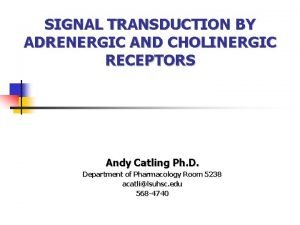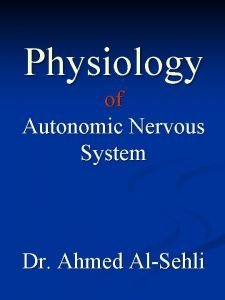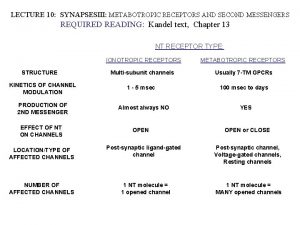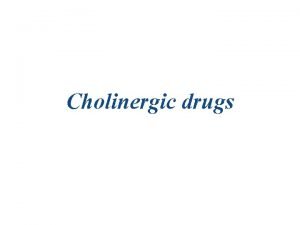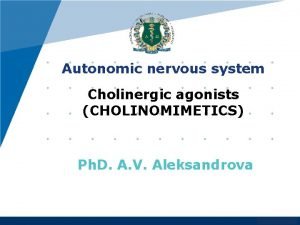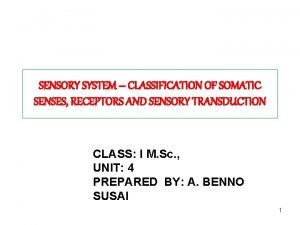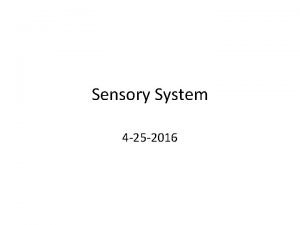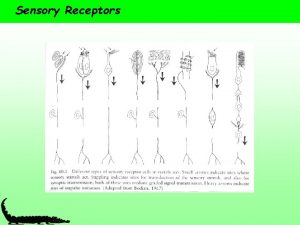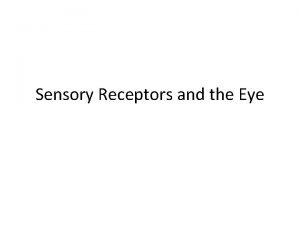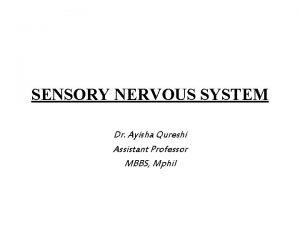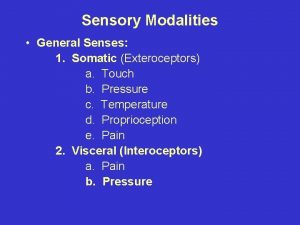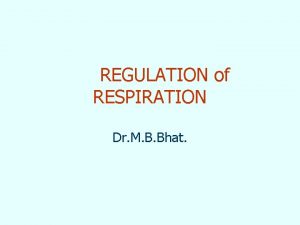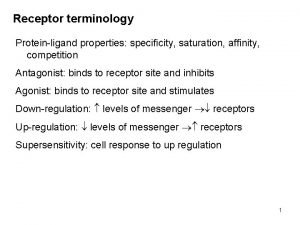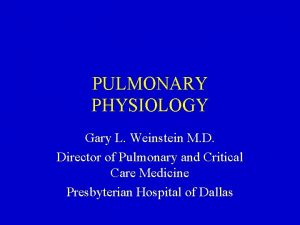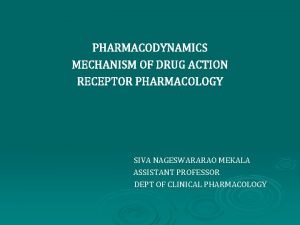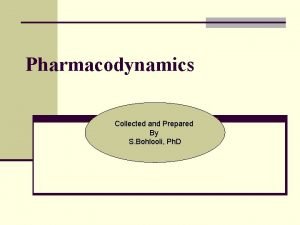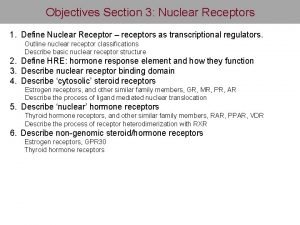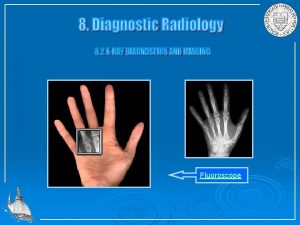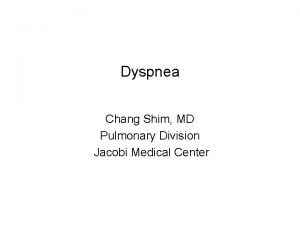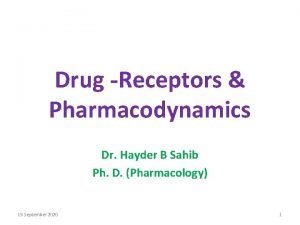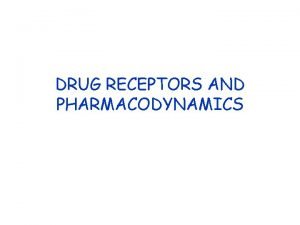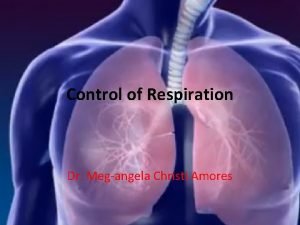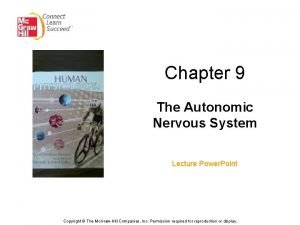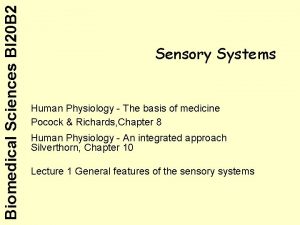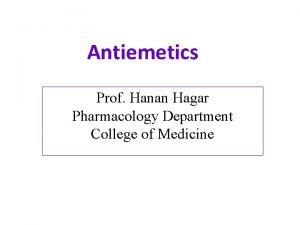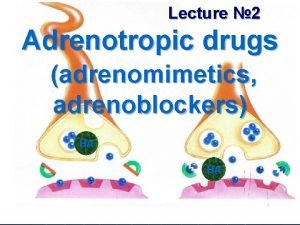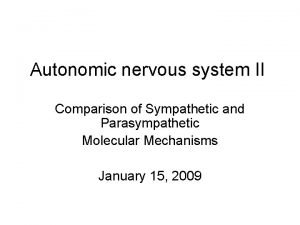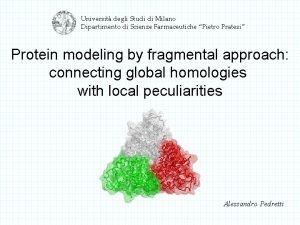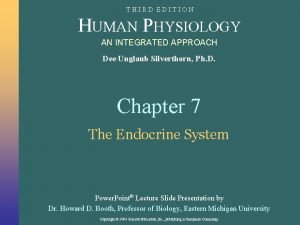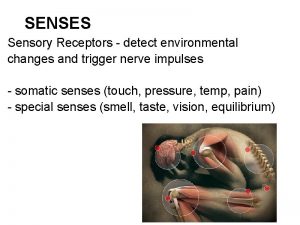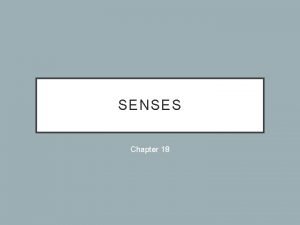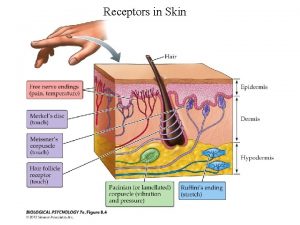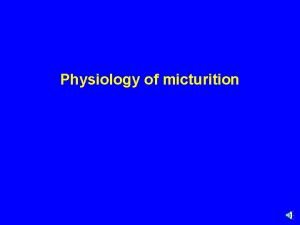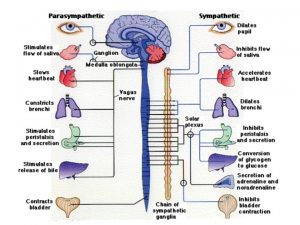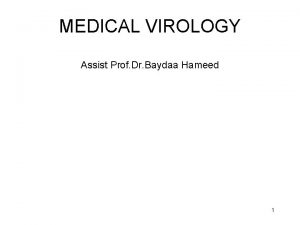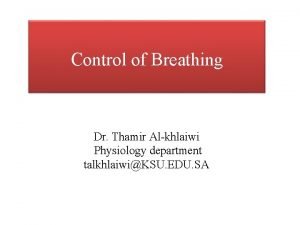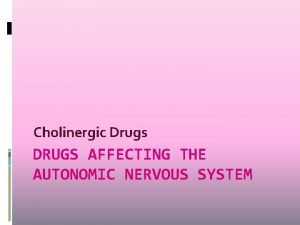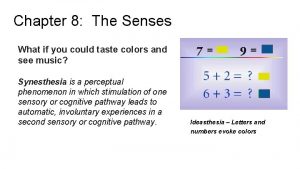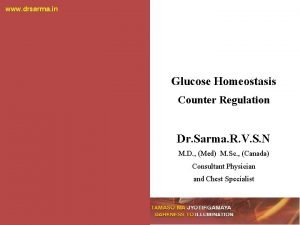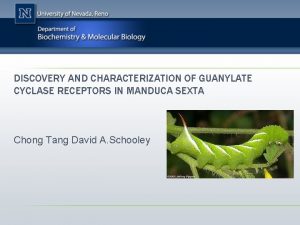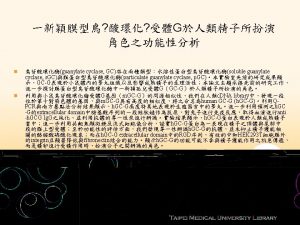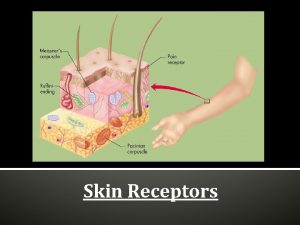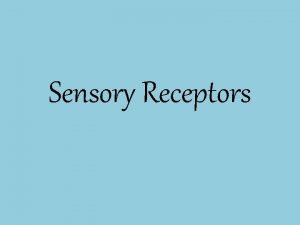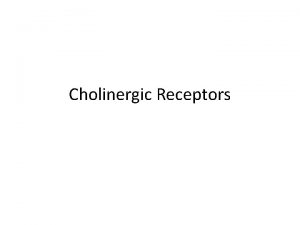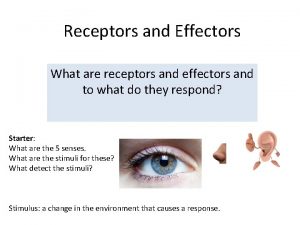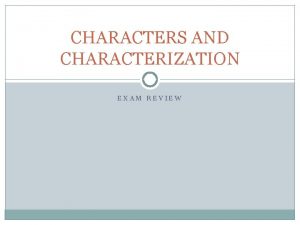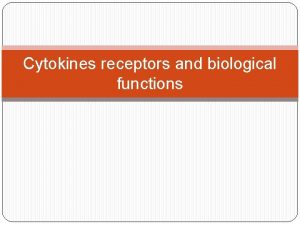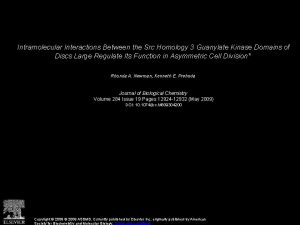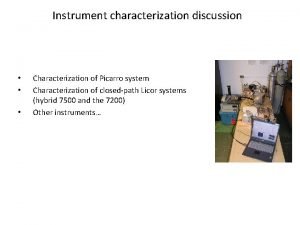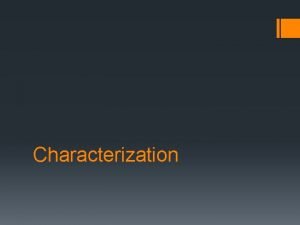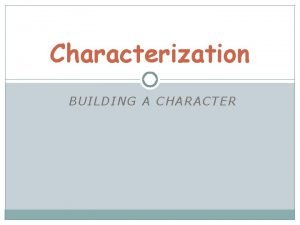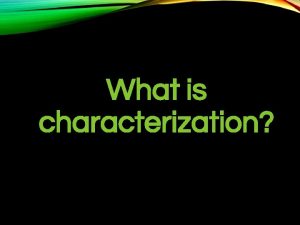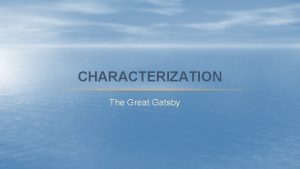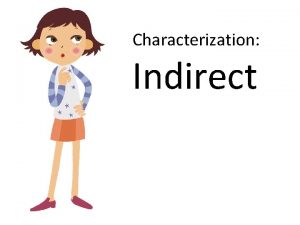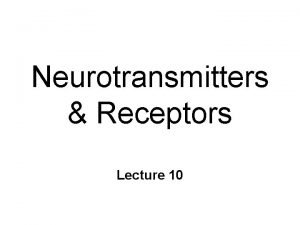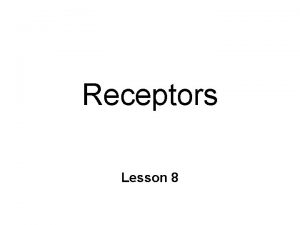DISCOVERY AND CHARACTERIZATION OF GUANYLATE CYCLASE RECEPTORS IN

























































- Slides: 57

DISCOVERY AND CHARACTERIZATION OF GUANYLATE CYCLASE RECEPTORS IN MANDUCA SEXTA Chong Tang David A. Schooley

BACKGROUND • Guanylate Cyclase Receptors • Insect water homeostasis • Peptides activating c. GMP elevation

GUANYLATE CYCLASE RECEPOR • Three different types of receptor

GPCR AND IONIC CHANNEL RECEPTOR • Ionic channel receptor(ex. nicotinic receptor )-The binding of ligand changes the conductance properties of the receptor channel, thereby causing depolarization and tissue activation • G-protein coupled receptor Ligand binding domain Transmembrane domain Intracellular domain (ex. DH receptor)

BIOCHEMISTRY OF GUANYLATE CYCLASE RECEPTOR • Signal peptide • ECD • ICD(PKLD, GCD)

GUANYLATE CYCLASE RECEPTOR • Classfication: GC-A (NPRA-ANP, BNP), GC-B (NPRB-CNP), NPRC, GC-D, E, F (orphan receptors) • Function: NPRA- acts to reduce the water, sodium and adipose loads on the circulatory system, thereby reducing blood pressure • NPRB-various cardiovascular diseases • NPRC-clearance receptor • GCC-uroguanylin receptor • Soluble guanylate cyclase and receptor guanylate

SOLUBLE GUANYLATE CYCLASE • s. GC activity is regulated by NO, GTP, ATP and allosteric activator. • There are isoforms in animals including α 1, α 2, β 1 or β 2 subunits. Manduca have a different β 3. • SDIVGFIA, DVYKVETIGD and MPRYCLFG are more conserved. Bold characters (Gly, Arg, & Cys) determine the substrate specificity


ANP WATER HOMEOSTASIS Water osmosis

INSECT WATER HOMEOSTASIS • The primary organs of salt and water balance for insects are generally Malpighian tubules, salivary glands, midgut and hindgut • Malpighian tubules blind-end tubes secrete KCl or Na. Cl rich urine (by active transport), so water and solutes follow by passive diffusion • Reabsorption in ileum and rectum


DIURETIC PEPTIDES • The corticotropin-releasing factor related diuretic hormone family has over 30 identified members • DH ligands for GPCR, their binding elevates c. AMP concentration • increase Na+ conductance across Na+/K+/2 Cl- cotransporter • Increase Na+/H+ antiporter with a higher concentration of

ANTIDIURETIC PEPTIDES • those that inhibit MT secretion and those that stimulate fluid reabsorption (neuroparsins, CTSH, ITP, ADF) • chloride transport stimulating hormone (CTSH)- stimulate chloride transport into the rectum via c. AMP

PEPTIDES ACTIVATING CGMP ELEVATION • ANP/BNP c. GMP regulated/dependent proteins: c. GMP-dependent protein kinase (PKG), c. GMP selective phosphodiesterase (PDE), and cyclic nucleotide-gated ion channels. • renin, aldosterone, and angiotensin stimulate sodium and water retention • EH ADF ITP CHH CAP 2 b

INSECT ECDYSIS INVOLVED HORMONE-EH • The synthesis and secretion of a new cuticle by the epidermis, the subsequent shedding of the old cuticle (ecdysis), and the process of eclosion. • the preecdysis sequence (serves to loosen attachment between the old and new cuticle) and the ecdysis behavior (consists of rhythmic anterior-moving peristaltic waves which culminates in shedding of the cuticle). The ecdysis behavior is controlled by EH and ETH together. • Blood-borne EH acts on the Inka cell to cause c. GMP production and PETH/ETH depletion in a positive feedback loop {Zitnan, 2012}.

POSITIVE FEEDBACK LOOP • Eclosion hormone (EH) and ecdysistriggering hormone (ETH) work together on a number of targets to cause eclosion • Epitracheal glands (Inka cell) contain ETH • EH act on Inka cells to induce the release of PETH and ETH by c. GMP elevation {Zitnan, 2003 #6198} • ETH then acts on its receptor (ETHRA) in VM neurons in the brain to elicit further EH release.

EH RECEPTOR-GCR IN INSECT • EH receptor from Bactrocera dorsalis, Bdm. GC-1, a guanylate cyclase receptor {Chang, 2009} • Similar to NPR 5 • Isoform of Bdm. GC-1 and NPR 5

INSECT ANTIDIURETIC FACTORS: (ADF) • Tenmo-ADFa, is exceptionally potent (EC 50 ~ 10 f. M) {Eigenheer, 2002}, and is also a potent antidiuretic in Aedes aegypti, whereas Tenmo. ADFb is much less potent in Tenebrio, with an EC 50 of 240 p. M (in the cricket Acheta domesticus diuretic action) • The likely mode of action is that a c. AMP-specific phosphodiesterase is activated by c. GMP {Quinlan, 1998}, leading to the rapid degradation of c. AMP that mediates diuretic hormone activity.

ION TRANSPORT PEPTIDE: ITP • Ion transport peptide (ITP) in locusts was identified as having antidiuretic activity in the ileum, stimulating Cl- transport 10 fold, Na+ transport ~2 fold, K+ permeability ~3 fold, and isoosmotic fluid absorption ~4 fold • Knocking out ITP cause the mortality in ecdysis stage • ITP is a 72 amino-acid peptide that has ~40% sequence identity with crustacean hyperglycemic hormone (CHH)

• Protein kinase A, after stimulation by c. AMP, activates the apical Cl- pump and opens K+ and Cl- channels in the apical and basolateral membranes. • c. AMP can not mimic the function of ITP

INSECT DIURETIC PEPTIDE: CAP 2 B • CAP 2 b is a diuretic in Drosophila melanogaster, elevating c. GMP in the Malpighian tubule through the intermediacy of nitric oxide • Action Model: Stimulate phospholipase C, producing IP 3, and causing the release of Ca+2 from internal stores that stimulate entry of external Ca+2, activate a cascade consisting of Ca+2 -calmodulin-dependent nitric oxide synthase and, subsequently, guanylate cyclase and the VATPase • Quinlan et al. {, 1997} showed CAP 2 b, and c. GMP, to have an antidiuretic effect in Rhodnius prolixus.

CRUSTACEAN HYPERGLYCEMIC HORMONE-CHH • A family of neuropeptides include crustacean hyperglycemic hormone (CHH), molt inhibiting hormone (MIH), and vitellogenesis inhibiting hormone (VIH). • Different CHH isoforms have multifunctional roles in decapods; they play a central role in carbohydrate metabolism, but one (molt inhibiting hormone, MIH) also exerts an effect on the molt and reproduction. • CHH has been reported to have osmoregulatory functions in several species of crustaceans • In the lobster, the crustacean hyperglycemic hormone (CHH) has been shown to act on target tissues to elevate c. GMP level via a r. GCase {Goy, 1990}. More recently, Lee et al. {, 2007} have shown CHH and MIH to act via c. GMP in the crab.

EXPERIMENT • Searching for guanylate cyclase receptor • Clone guanylate cyclase receptor • Characterize guanylate cyclase receptor

• Alignment of receptors homologous to Rattus norvegicus GC-A in different species. Rattus norvegicus GC-A (AAI 28743), Bactrocera dorsalis (ACQ 90240), Tribolium castaneum (XP_970405), Bombyx mori (BGIBMGA 006891 PA), Aedes aegypti (XP_001653226), Apis mellifera (XP_001120461), Drosophila mojavensis (XP_001999659).

SEARCHING FOR GUANYLATE CYCLASE DOMAIN • RNA preparation • Reverse transcription • Degenerate PCR to get guanylate cyclase domain • Clone to T-vector and sequence

RNA PREPARATION Composition Final concentration weight Guanidinium thiocyanate 0. 8 M 118. 16 g Ammonium thiocyanate 0. 4 M 76. 12 g Sodium acetate (p. H 5) 0. 1 M 33. 4 ml of 3 M stock Glycerol 5% 50 ml Phenol 38% 380 ml Adjust p. H to 5

REVERSE TRANSCRIPTION • NEB MMLV reverse transcriptase, Roche reverse transcriptase AMV, Roche Transcriptor, Clontech SMART reverse transcriptase, and Clontech SMARTscribe reverse transcriptase (data are not shown).


DIFFICULTIES IN DEGENERATE PCR • The DVYKVETI degenerate primer (GAYGTNTAYAARGTNGARACNAT) has 2 X 4 X 2 X 4=1024 • RACE PCR is much more difficult that degenerate PCR • Touch-down program • Hot-start Taq is better than Pfu • No results on that




DEGENERATE PCR • NPR 5: AETYG-sense -T/C • 5' GCI GAR ACI TAT/C GG 3' • NPR 5: GCD-antisense • 5' CAGCAGCAGGCGC 3'


3 RACE PCR

5 RACE PCR

PCR BUFFER WITH COCL 2

5+3 RACE

Manduca sexta Bombyx BGIBMGA 006891 -TA Tribolium NCBI Drosophila NCBI XP_971364 CG 42637 A-C NPR 5 1092 AA NPR 6 500 AA 006799 -TA XP_970405. 1 CG 10738 -PA 003981 -TA&3982 - XP_975601. 2 TA CG 3216 -PB NPR 7 1022 AA NPR 8 1197 AA None found XP_001809661. 1 CG 33114_PB SP Q 9 BPR 0 NP_001167546. 1 CG 31183 NPR 1 1102 AA NPR 2 soluble NPR 3 soluble

Num Mg. Cl 2 (25 GC ber m. M) solution 1 48 2 0 DMSO (100%) d. NTP (10 m. M) Buffer Water 40 40 20 80 with 1. 8 m. M Mg. Cl 2 212 260 3 4 5 64 64 0 40 80 0 20 80 with 1. 8 m. M Mg. Cl 2 196 156 300 6 7 8 9 48 64 48 0 0 0 160 20 80 with 1. 8 m. M Mg. Cl 2 252 236 92 140 10 64 160 20 80 76 Table 8. Optimized conditions for PCR. All the figures are based on µl per 200 µl total volume. 5 x GC Buffer: 2. 5 M MMNO (N-Methylmorpholine N-oxide) with 2. 5 M proline, or 2 M MMNO with 2 M proline. The final working concentration is 0. 4 - 0. 5 M.

NPR 5 THIRD FRAGMENT

NPR 5 MUTATION

MUTAION TECHNOLOGY

BRIDGE THE PIECES

QPCR

PRELIMINARY HORMONE DOSE-RESPONSE CURVE FOR NPR 5 • c. GMP competitive binding assay

DISCCUSION-SEQUENCE ANALYSIS • Sequence analysis by signal. P server • Recently, Manduca sexta genome is nearly completed.

DISCUSSION-ALTERNATIVE SPLICING ISOFORMS • NPR 5 has a mutation between the kinase domain and the guanylate cyclase domain • ACGCCCCTCCGACCCCCACGCTGCTGCGGAGA CTCGCCATACCGGACCCGACGCCTTACAGGTATGTGTCATCTGCAACACTATAGCCACTAC TAACCAGCTGT • TACCTACAATTTATAAAATTAAATACTCTGTAAA TAGTAGTGACTCAGCCGTTGAACAAAAAACAAATATTAAAATGTATTTTCAGACCTCC TCTGGACGCTCTCG

FUNCTION OF MUTATION • In the closely related silkworm, there is no intron in this region. Tribolium neither. • This stop codon may not have a biological role • function as a dominant negative regulator of the functional receptor. • the splicing form without guanylate cyclase activity may function as a clearance receptor • NPR 1 has 3 different isoforms in the 3 end and 2 different isoforms in the 5 end

TISSUE LOCALIZATION • The Q-PCR data indicate that all of these receptors are expressed in the tubule, and four in the trachea, ileum, and head, but at lower levels • NPR 5 is the Manduca orthologue of the Bactrocera EH receptor • Very recent results of characterizating the NPR 5 receptor show that it responds similarly to Schgr-ITP and Tenmo. ADFb (the Manduca orthologs of ITP and ADF) • NPR 5 and NPR 8 are moderately abundant in tracheae, which is the respiratory system in Manduca • NPR 8 is most similar to the rat ANP receptor

NPR 6 • Immune function? • Metabolism function?

FUTURE WORK • RNAi in Tribolium • Produce antibody to do immunohistory • More biological analysis

REFERENCE • More in thesis

THANK YOU • First, I want to give my biggest appreciation to Dr. Schooley • Dr. Cushman (half year), Dr. Misono (two years) • Dr. Shintani, Dr. Tittiger • Dr. Keef, Dr. Blomquist • Dr. Harper



 Adenylyl cyclase
Adenylyl cyclase Define indirect characterization
Define indirect characterization Indirect characterization
Indirect characterization Cholinergic vs adrenergic
Cholinergic vs adrenergic Orbelli phenomenon
Orbelli phenomenon Difference between ionotropic and metabotropic receptors
Difference between ionotropic and metabotropic receptors Blocking muscarinic receptors would
Blocking muscarinic receptors would Muscarinic vs nicotinic receptors
Muscarinic vs nicotinic receptors Tuberous receptors
Tuberous receptors Olfactory receptors
Olfactory receptors Classification of sensory system
Classification of sensory system Umami taste receptors on tongue
Umami taste receptors on tongue Thermoreceptor
Thermoreceptor Classification of sensory receptors
Classification of sensory receptors Sensory receptors in the eye
Sensory receptors in the eye Receptive fields of sensory neurons
Receptive fields of sensory neurons Exteroceptors examples
Exteroceptors examples 3 types of lung receptors
3 types of lung receptors Heads paradoxical reflex
Heads paradoxical reflex Intracellular receptors
Intracellular receptors J receptors
J receptors Receptors in pharmacology
Receptors in pharmacology Pharmacodynamics
Pharmacodynamics Nuclear receptors
Nuclear receptors Npte pharmacology
Npte pharmacology 4 types of image receptors
4 types of image receptors Jan j shim md
Jan j shim md Spare receptors
Spare receptors Therapeutic index definition
Therapeutic index definition Respiratory ramp
Respiratory ramp Preganglionic and postganglionic parasympathetic neurons
Preganglionic and postganglionic parasympathetic neurons Hearing and equilibrium
Hearing and equilibrium Classification of sensory receptors
Classification of sensory receptors Chemoreceptor trigger zone receptors
Chemoreceptor trigger zone receptors Adrenergic receptors
Adrenergic receptors Classification of sensory receptors
Classification of sensory receptors Alpha 2 receptors location
Alpha 2 receptors location Nicotinic vs muscarinic receptors
Nicotinic vs muscarinic receptors Alpha 2 receptors location
Alpha 2 receptors location Alpha adrenergic agonist
Alpha adrenergic agonist Nicotine acetylcholine receptors
Nicotine acetylcholine receptors Peptide hormone receptors
Peptide hormone receptors Thermoreceptors
Thermoreceptors Sensory receptors
Sensory receptors Tobacco treatment specialist certification
Tobacco treatment specialist certification Pain receptors in brain
Pain receptors in brain Receptors of urinary bladder
Receptors of urinary bladder Oldcart
Oldcart Opioid receptors location
Opioid receptors location Pain receptors in brain
Pain receptors in brain Simpaticolitici naturali
Simpaticolitici naturali Viral receptors
Viral receptors Proprioceptors
Proprioceptors Site:slidetodoc.com
Site:slidetodoc.com Cholinergic agents
Cholinergic agents Pain receptors
Pain receptors Glut receptors
Glut receptors Venlafaxine
Venlafaxine



